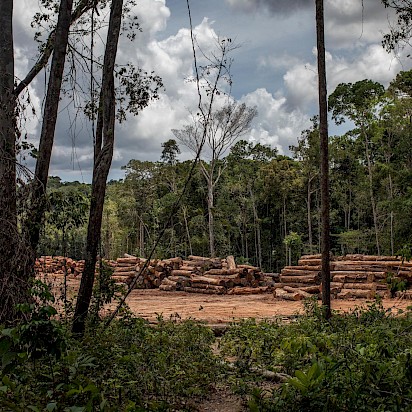The Glasgow deforestation pledge isn't enough to save our forests
 The 2015 Paris climate agreement called on nations of the world to preserve forests and other ecosystems that store carbon. But forests continue to disappear — cut and burned and fragmented into ever smaller patches. This failure challenges all of our other climate efforts because unless forests remain standing, the world will never contain global warming.
The 2015 Paris climate agreement called on nations of the world to preserve forests and other ecosystems that store carbon. But forests continue to disappear — cut and burned and fragmented into ever smaller patches. This failure challenges all of our other climate efforts because unless forests remain standing, the world will never contain global warming.
In one of their first major actions this week, delegates at the global climate conference in Glasgow pledged to end deforestation, committing $12 billion to the effort, with an additional $7 billion from the private sector. But this is not the first time such a promise has been made, and yet deforestation has continued.
There are steps the world can take now to stop it. Territorial rights of Indigenous peoples must be recognized, protected forest areas expanded and roads and industry avoided in still intact forests. These steps can set the stage for more sustainable forest economies.
Here’s a snapshot of the crisis: Last year the loss of primary old-growth tropical forest rose by 12 percent over 2019, according to the World Resources Institute. That loss added about twice as much carbon dioxide to the atmosphere as what’s emitted by cars in the United States every year, the institute estimated.
More ominous, the often overlooked northern boreal forests grow in soils that hold carbon equal to 190 times the global carbon emissions of last year and are being relentlessly diced and burned. This is accelerating the thawing of permafrost as the planet warms, releasing greenhouse gases in the process.
We’re losing a battle we can win, but only by keeping trees on our side.
It’s a matter of simple biology. Through photosynthesis, trees and plants absorb carbon dioxide from the atmosphere, and the carbon becomes part of the plants and soil. Large forests tend to be ecologically healthy, and this healthy biology results in carbon storage on a gargantuan scale.
Intact forests around the world absorbed around 28 percent of all carbon dioxide emissions from 2007 to 2016, a huge reduction in the accumulation of the planet-warming gas in the atmosphere. In the tropics, intact forests store an average of twice the carbon held in forests bisected by roads or otherwise disturbed by development.
That’s why we must let the big forests stand.
The nations richest in intact forest landscapes (defined as unbroken woodlands of slightly more than 190 square miles) are Canada, Russia, Brazil, the Democratic Republic of Congo, Peru and the United States. Two of those countries, Brazil and the Democratic Republic of Congo, led the world in primary forest loss in 2020, and Peru ranked fifth on that list.
Globally, 10 percent of intact forest landscapes were fragmented or cleared in the first 16 years of this century, and half of the remainder are designated by governments for logging, mining and oil and gas extraction.
Protecting tropical forests can secure seven to 10 times as much carbon through 2050 as replanting forests. Saving the trees can also ease the crisis of species extinction. And protecting these forests is crucial to maintaining the homes and ways of life of thousands of forest cultures — people who speak as many as a quarter of Earth’s languages.
These communities aren’t exempt from economic pressures and development aspirations. But those forces are moderated by relationships tribes have with the ecosystems that are integral to their languages, identities, spirituality and survival.
Leaders determined to save climate-cooling forests can support these forest guardians by enacting — and maintaining — land policies that assure Indigenous peoples’ inalienable rights to their full territories.
Brazil, often in the public eye for deforestation and forest fires, would be in vastly worse shape without its exemplary recognition of Indigenous territories, enshrined in the country’s 1988 Constitution. Since then, tribes have formally secured nearly 260 million acres of the Amazon — five times the area of all Native American reservations in the United States — providing a measure of protection against a currently problematic Brazilian administration and the incursions of extractive industries.
Still, the majority of intact forests around the world lie outside Indigenous lands and require greater protection. One bit of good news is that parks and reserves quadrupled in area, to 17 percent of Earth’s land, between 1990 and 2020, an astounding success. As part of the world’s Convention on Biological Diversity, most nations have agreed to increase protection to 30 percent of their land by 2030. Based on a study of protected areas in the Andean Amazon, we estimate that unprotected intact forests on public lands around the world could be safeguarded at a cost of $1 to $2 a year per acre.
Many of these intact forests have people living in them, with sustainable livelihoods that can be perpetuated by protection. And this protection has a spillover benefit: It provides an incentive to restore and more carefully manage already degraded lands for food, wood and other products.
As has become starkly clear, humans have the means to bake the biosphere we live in. Avoiding that outcome is more than a matter of adjusting the dials of our technologies and fuels. Finding our way through the climate crisis also requires that we remember how our home planet works — as a linked biological and physical system with a beating, photosynthesizing, rainmaking heart of wild woods.
You can return to the main Market News page, or press the Back button on your browser.

